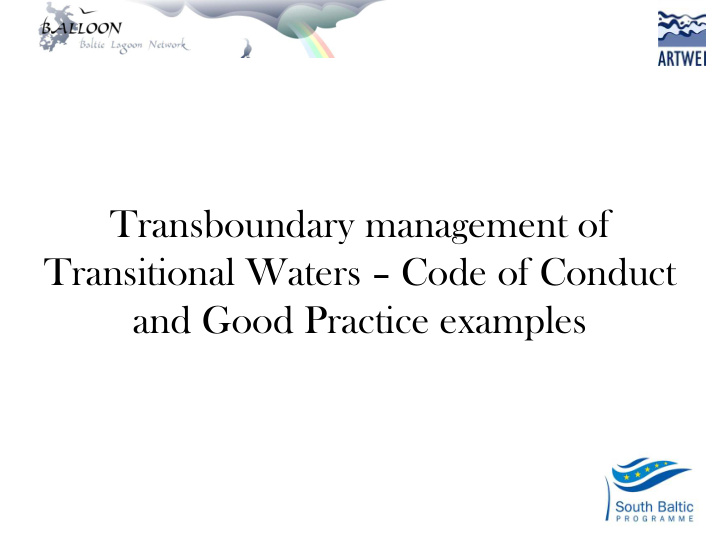



Transboundary management of Transitional Waters – Code of Conduct and Good Practice examples
A couple of weeks old as a physically published document
The The ob objective To provide guidelines for transboundary management of transitional waters. The guidelines are based on good practice examples of already implemented actions collected mainly from the south Baltic Sea but also from elsewhere in Europe and North America.
33 case studies have been compiled based on the experience of the project partners and other stakeholders in the four project target areas.
Each case study is summarized within the relevant chapters as “box”: Experiences that can be exchanged Overview of the case ICZM tools . Success and failure factors .
Preface Introducing transitional waters Ecosystem goods and services of transitional waters Management challenges for the South Baltic transboundary transitional waters Key issues in transboundary reinforcement of environmental integrity of transitional waters Towards a strategy for reinforcement of environmental integrity of transitional waters Planning for management of transboundary transitional waters Information management in the reinforcement of the environmental integrity of transboundary transitional waters Strategic environmental assessment in a transboundary transitional water body Financial sustainability of transboundary cooperation in transitional water management Research, monitoring, evaluation and review Stakeholders’ involvement in nature management in the context of environmental integrity of transboundary transitional waters
The most critically important challenges for the management of the South Baltic transboundary transitional waters are the ones that threaten the transitional waters’ ecosystem integrity. Co- operation between the countries on natural or technological hazard prevention, or transboundary environmental impact assessment of possible large-scale development projects, is still missing in the countries sharing the south Baltic lagoons
The first step in transboundary co-operation usually is the need to negotiate the quotas for commercial fish landing on a regular basis – that was implemented in most of reviewed cases. For further success a high-level political commitment in countries sharing a transboundary transitional water body and a joint umbrella agreement on key issues of common concern and potential principal solutions
For the co-operation agreement to be truly effective, it must be supported by three key elements: dedicated professional agency established jointly by the cooperating countries, integrated management plan and common information sharing platform.
Lagoon indicators
Indicator classification • Natural processes - and nature conditions (sensu MSFD) • Socio-economics part of development / layer existing in context of lagoon • Local or regional government policy or cooperation • Endangering for habitats (biodiversity, conditions) and human economy influence/ factors - natural and anthropogenic ones
Europe pean M an Mari rine St Strat rategy F Fram ramework Directi tive • aims to achieve healthy marine waters by 2020. • applies an integrated approach to ecosystems • calls for the development of a marine strategy by each Member State. – By 2012, they must provide a comprehensive assessment of the state of the environment, identifying the main pressures on their respective marine regions, and defining targets and monitoring indicators. – By 2015, they will have to develop coherent and coordinated programmes of measures to achieve Good Environmental Status (GES). – To reach the 2020 target, they will have to achieve efficient communication and close cooperation, notably through regional sea conventions.
Background “The first symptom of the eutrophication of the waters in the Lagoon occurred in prewar times. But year by year, the volumes of the agricultural, industrial and municipal waste water increased, especially following the period between 1955 and 1965. This period marked the beginning of the heavy eutrophication of the Curonian Lagoon, due to the poor water quality of the River Nemunas” HELCOM Thematic report (October 2000)
Fishery & food webs(MFD) • Pelagic/benthic fish ratio • Maximum length of fish • Nutritional status of key species • ECOPATH derived parameters
• 1. natural processes - and nature conditions (clear, not polluted etc) • 2. Socio-economics part of development / layer existing in context of lagoon • 3. Local or regional government policy or cooperation • 4. Endangering for habitats (biodiversity, conditions) and human economy influence/ factors - natural and anthropogenic ones
WFD parameters • Classification • Macrophytes • Phytoplankton • Benthos • Chemistry • Residence time (modelled)
Recommend
More recommend